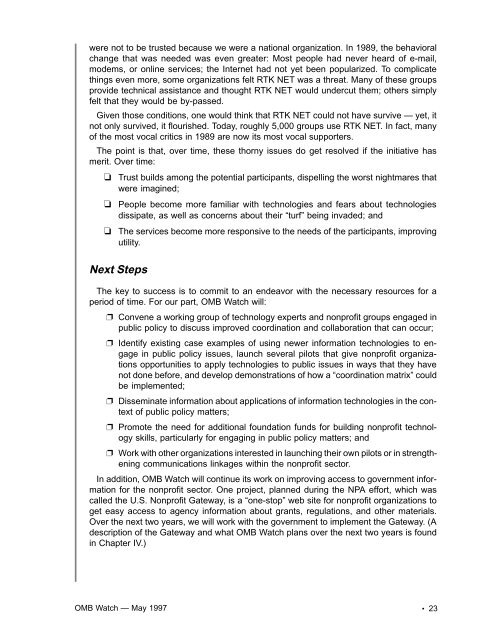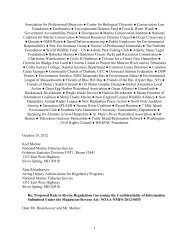About OMB Watch
Chapter III Technology Advisory Committee - OMB Watch
Chapter III Technology Advisory Committee - OMB Watch
- No tags were found...
Create successful ePaper yourself
Turn your PDF publications into a flip-book with our unique Google optimized e-Paper software.
were not to be trusted because we were a national organization. In 1989, the behavioral<br />
change that was needed was even greater: Most people had never heard of e-mail,<br />
modems, or online services; the Internet had not yet been popularized. To complicate<br />
things even more, some organizations felt RTK NET was a threat. Many of these groups<br />
provide technical assistance and thought RTK NET would undercut them; others simply<br />
felt that they would be by-passed.<br />
Given those conditions, one would think that RTK NET could not have survive — yet, it<br />
not only survived, it flourished. Today, roughly 5,000 groups use RTK NET. In fact, many<br />
of the most vocal critics in 1989 are now its most vocal supporters.<br />
The point is that, over time, these thorny issues do get resolved if the initiative has<br />
merit. Over time:<br />
❏ Trust builds among the potential participants, dispelling the worst nightmares that<br />
were imagined;<br />
❏ People become more familiar with technologies and fears about technologies<br />
dissipate, as well as concerns about their “turf” being invaded; and<br />
❏ The services become more responsive to the needs of the participants, improving<br />
utility.<br />
Next Steps<br />
The key to success is to commit to an endeavor with the necessary resources for a<br />
period of time. For our part, <strong>OMB</strong> <strong>Watch</strong> will:<br />
❐ Convene a working group of technology experts and nonprofit groups engaged in<br />
public policy to discuss improved coordination and collaboration that can occur;<br />
❐ Identify existing case examples of using newer information technologies to engage<br />
in public policy issues, launch several pilots that give nonprofit organizations<br />
opportunities to apply technologies to public issues in ways that they have<br />
not done before, and develop demonstrations of how a “coordination matrix” could<br />
be implemented;<br />
❐ Disseminate information about applications of information technologies in the context<br />
of public policy matters;<br />
❐ Promote the need for additional foundation funds for building nonprofit technology<br />
skills, particularly for engaging in public policy matters; and<br />
❐ Work with other organizations interested in launching their own pilots or in strengthening<br />
communications linkages within the nonprofit sector.<br />
In addition, <strong>OMB</strong> <strong>Watch</strong> will continue its work on improving access to government information<br />
for the nonprofit sector. One project, planned during the NPA effort, which was<br />
called the U.S. Nonprofit Gateway, is a “one-stop” web site for nonprofit organizations to<br />
get easy access to agency information about grants, regulations, and other materials.<br />
Over the next two years, we will work with the government to implement the Gateway. (A<br />
description of the Gateway and what <strong>OMB</strong> <strong>Watch</strong> plans over the next two years is found<br />
in Chapter IV.)<br />
<strong>OMB</strong> <strong>Watch</strong> — May 1997<br />
• 23



